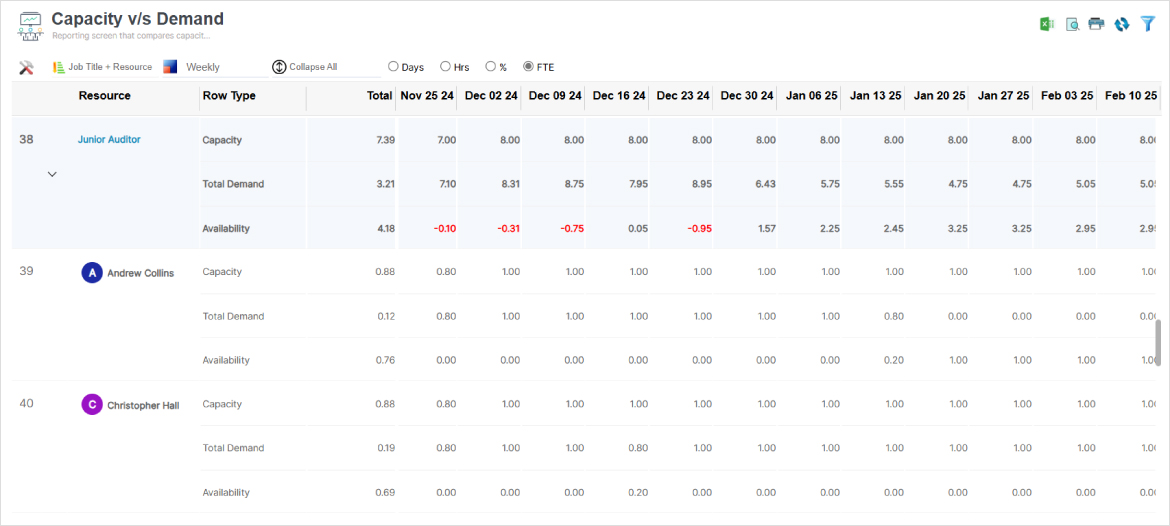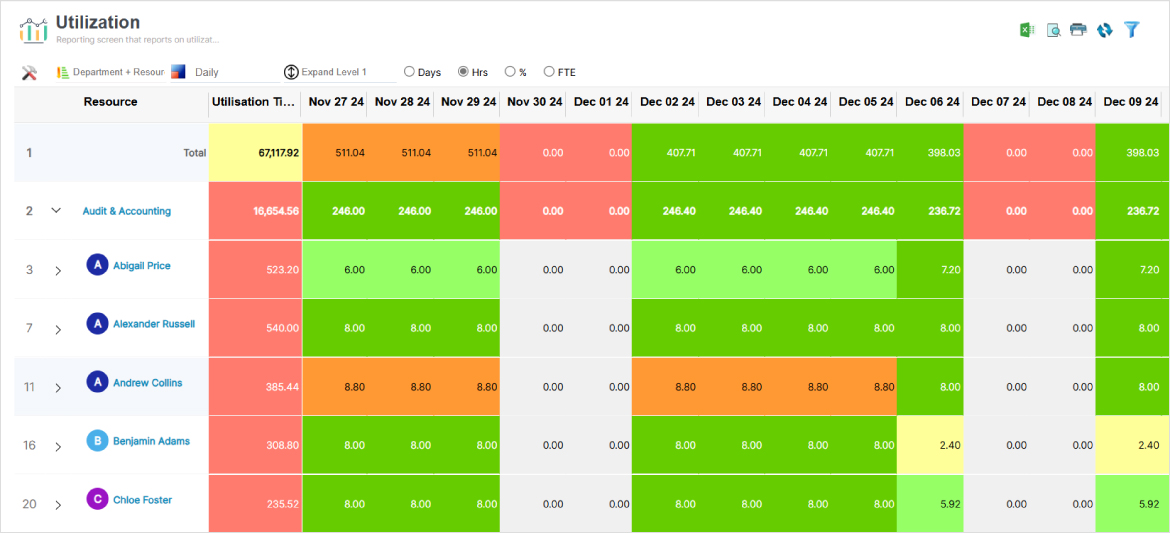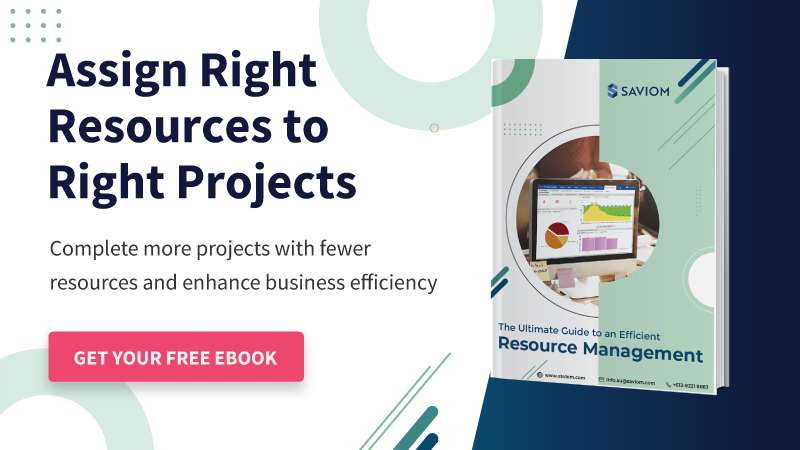In the current competitive business environment, utilizing and managing resources intelligently is imperative as they are the most high-priced investments of any firm. However, as organizational structures have evolved from traditional hierarchies to intricate matrix systems spanning multiple geographies, the challenges associated with managing resources have also become increasingly complex.
Therefore, mastering the art of effective resource management has now become a critical cornerstone for organizational success. It ensures the right resources are allocated effectively across projects and that their skills are utilized to the maximum potential for successful project delivery. It also helps break informational silos and ensures data-driven decision-making.
This blog will provide an in-depth insight into resource management concepts. But first, let’s understand the definition of resource management.
What is Resource Management?
Resource management is the process of planning, forecasting, scheduling, and optimizing the entire resource lifecycle for successful project delivery. These resources include personnel, time, financials, equipment & tools, supply inventory, etc.
The main objective of resource management is to fulfill the project requirements and ensure the productive utilization of every resource across the organization. In addition, it helps build a future-ready workforce, improve business profitability, and beat market volatility.
Types of Resource Management
Given below are some of the types of resource management that organizations manage across projects-
Human Resource Management
Human resource management is the strategic approach to effectively manage an organization’s most valuable asset, the workforce, to achieve its goals and objectives. It encompasses recruiting, developing, retaining, and enhancing workforce productivity while optimizing the resource health index. This will help ensure seamless project delivery, improve overall billability, and drive organizational growth.
Finance Resource Management
Finance resource management refers to the process of efficient forecasting, planning, and allocation of monetary assets to suitable projects. This includes assessing organizational objectives, prioritizing initiatives, identifying and mitigating financial risks, etc., that help firms meet their business goals within budget. Consequently, this ensures projects are delivered smoothly, while improving the overall ROI.
Equipment Resource Management
Equipment resource management involves effective sourcing, scheduling, utilization, and maintenance of physical assets essential for business operations. This involves inventory tracking, performance monitoring, ensuring safety and operational standards compliance, etc. This enables firms to ensure timely availability of tools, for seamless project initiation and progress.
How do you Create a Resource Management Plan?
A resource management plan is a comprehensive document that outlines the type, quantity, and quality of resources required for each project phase. This helps managers to improve resource estimate accuracy and streamline project workflow.
However, how can you create an efficient resource management plan?
Given below are four steps to create one-
Step 1: Determine the project requirements & budget from related documents like project charter, work breakdown structure, project schedule, quality standards & metrics, and risk register.
Step 2: Accordingly, managers must outline the various resource attributes like quantity, skills, competencies, experience, capacity, availability, timelines, etc., required for each phase of the project.
Step 3: Next, assess, acquire, and allocate the most suitable resources to tasks/ projects at the right time and cost. This helps avoid over or under-allocation of resources and ensures seamless project initiation.
Step 4: Monitor resource performance through KPIs, identify potential risks early on, and take corrective measures. For instance, managers can track workforce utilization levels consistently and, in case of discrepancies, implement suitable measures to optimize them.
Now, let’s explore the resource management process through an example.
Resource Management Process: A Real-life Example
Let’s examine the execution of an audit and accounting project and explore how the above concepts are applied in practice.
At the outset, project managers clearly outline the project’s goals, considering factors such as the scope of the audit, regulatory compliance requirements, complexity of financial statements, timelines, client-specific needs, etc. They also specify the duration, the various stages of the project, dependencies, etc.
They then determine the resources needed for each project stage, including skilled personnel (auditors, accountants, tax consultants, financial analysts, etc.)
Given below is a breakdown of the same-
- Planning and Risk Assessment: 1-3 senior auditors, 1-2 tax consultants, 2-3 junior auditors
- Internal Control Testing: 3-5 senior & junior auditors and 2 internal control specialists.
- Testing & Data Analysis: 2-3 junior auditors and 2-3 data analysts.
- Tax Compliance Review: 2-3 tax consultants, 2 accountants, and 1 legal advisor.
- Reporting & Finalization: 2-3 senior auditors, 2 accountants, and 1 editor/proofreader.
Once the project manager estimates the required resources, they send a resource request to the resource manager. Accordingly, he will do capacity planning to evaluate their current workforce repository and identify if the necessary resources are available within the internal talent pool for the scheduled timeline. They discover a potential shortage of junior auditors during the testing & data analysis stage and plan to onboard two contingent consultants in advance to address this gap.

SAVIOM’s advanced Capacity vs. Demand report helps managers proactively identify resource shortages or excesses on time.
Similarly, they assess the need for additional auditors, analysts, accountants, and other skilled professionals to ensure each project stage has the appropriate resources for the specific period. Resource managers then allocate these resources to this audit and accounting project. After that, the project manager selects the team of required resources and schedules them to appropriate tasks.

SAVIOM’s robust multi-dimensional scheduler enables managers to match the right resources to suitable projects based on department, location, skills, etc.
Given the labor-intensive nature of audit projects, managers must monitor resource utilization levels continuously. This is particularly important for skilled professionals, such as auditors, tax consultants, and analysts, who may become exhausted during resource-intensive stages like compliance reviews and reporting finalization.

SAVIOM’s robust Resource Utilization reports and color-coded heatmaps enable managers to optimize workforce utilization levels with ease.
These real-time insights will help managers implement the right optimization techniques and rectify instances of overutilization to maintain the resource health index and boost employee productivity.
Read More: All You Need To Know About Construction Resource Management
Now that we have explored an example let us see the significance of resource management in organizations.
Why is Resource Management Important?
Managing resources efficiently is critical to streamlining operations, optimizing costs, and enhancing project outcomes, making it an essential component for any business aiming for long-term success.
Let’s deep dive to understand the importance of resource management –
Minimizes Project Resource Costs Significantly
According to Deloitte, “Cost reduction takes precedence over other business initiatives.”
An efficient resource management framework provides enterprise-wide visibility and allows managers to utilize cost-effective global resources for projects. It also helps them create the right mix of local, global, on-demand, and permanent resources based on project requirements. Moreover, they can leverage a balanced blend of junior and senior employees for every project to ensure high-quality deliverables and reduce project resourcing costs.
Bridges the Capacity vs. Demand Gap
The resource management process allows managers to foresee pipeline project demand. That way, managers can conduct a capacity vs. demand analysis to identify if there are any resource excesses and shortages. In case of any variances, they can formulate a suitable action plan to bridge the demand gap and avoid last-minute firefighting activities.
Enhances Billable Resource Utilization
A proper resource management process helps ensure optimal utilization of all the employees within an organization. It empowers managers to foresee resource utilization in advance, which helps mobilize employees from non-billable to billable and strategic work. Additionally, it provides visibility into resources about to be rolled off from projects, allowing managers to bring forth project timelines or assign them to existing project vacancies. This will help improve the resource health index and overall billability.
Helps Futureproof the Workforce
A robust resource management process empowers firms to anticipate emerging market trends and identify evolving skill demands. Accordingly, managers can determine the areas where the workforce skills are lacking, and design tailored skill-building programs to bridge the gap. Thus, by enhancing resource competency, organizations can build a future-ready talent pool, seize upcoming opportunities, and maintain a competitive edge.
Overcomes Complexities of the Matrix Structure
Advanced resource management provides unmatched visibility into enterprise-wide resources and their attributes like- skills, locations, capacity, cost rate, etc., to create a single source of the truth. This enables managers to go beyond the limitations of geographical locations/departments, identify competent resources, and allocate them to suitable projects. Consequently, they can avoid matrix complexities like sub-optimal utilization, scheduling conflicts, etc., ensuring successful project delivery.
Read More: What is Matrix Management and Why is it Important?
Delivers Projects/Services Successfully
Efficient resource management allows managers to facilitate competent resource allocation. This prevents under/over-skilled resources from being assigned to mismatched tasks. Thus, when the right talent is engaged in suitable projects or tasks, they are more productive. This way, the resources can contribute effectively to achieving project goals, meeting deadlines, and ensuring work is completed within the stipulated time and budget.
The following section will discuss various resource management techniques utilized by managers for projects.
What are Resource Management Techniques?
Resource management techniques are the strategies and methods employed to allocate and utilize various resources within an organization or project. Some common techniques include:
Resource Planning
Resource planning is a comprehensive process of proactively planning, forecasting, and allocating resources to the most suitable projects. It also ensures efficient and effective utilization of resources as per their capacity/availability to drive favorable project outcomes within the stipulated time and budget.
Resource Forecasting & Capacity Planning
Resource forecasting enables managers to estimate pipeline project requirements well ahead of the curve. It helps them perform the capacity vs demand gap analysis to identify resource excesses and shortages. Accordingly, they can take suitable resourcing measures to create an optimal talent pool to meet project requirements.
Read More: What is Resource Capacity Planning? An Ultimate Guide for Every Project Manager
Resource Scheduling
Resource scheduling involves identifying and deploying competent resources such as people, equipment, materials, and facilities to various tasks for a specific period. These tasks can be anything from non-billable to billable/strategic work. This process helps managers to meet project deadlines and achieve business objectives seamlessly.
Resource Utilization
Resource utilization is a critical KPI that measures the time employees spend on different project tasks against their availability. It helps track and monitor resource utilization rates and determine if employees are over/under-utilized. Accordingly, managers can take necessary measures to optimize their utilization levels.
Resource Leveling
Resource leveling is an optimization technique applied to projects with flexible timelines. Here, managers adjust project schedules to balance resource demand with available supply, ensuring optimal resource utilization, increased productivity, and better financial outcomes.
Resource Smoothing
Resource smoothing or time-constrained scheduling (TCS) is an optimization technique for projects with fixed deadlines. Here, managers assess resource workloads and, in case of overutilization, redistribute tasks or bring in additional resources to ensure balanced resource utilization.
Having explored resource management techniques, knowing who needs this is essential. Read on.
Types of Businesses That Require Enterprise Resource Management
Industries such as IT, construction & engineering, audit & accounting, and professional services are increasingly adopting matrix-based setups, cross-functional teams, and shared-services models to deliver projects successfully, reduce costs, and maximize profitability.
However, these structures bring inherent complexities, exposing companies to a range of resource-centric challenges, including scheduling conflicts, high resourcing costs, skill shortages, and sub-optimal utilization. With multiple projects running simultaneously, organizations must ensure resources are allocated effectively to achieve the success of each project.
To tackle these challenges, organizations must develop a well-defined project resource management tailored to their specific needs. Regardless of industry, implementing a robust resource management strategy, supported by the right tools, is critical to managing the workforce efficiently and meeting business objectives.
Read More: How Can You Make Data-Driven Decisions with Resource Management Software?
Now, let us understand some basic resource management best practices that every manager must know.
10 Resource Management Best Practices
We know that effective management of resources is the cornerstone of every business, and it helps optimize workforce productivity, enhance project delivery, and maximize profitability.
Here is how adopting modern ERM software can prove instrumental in this process.
Gain Centralized Visibility of the Workforce Across the Organization
Advanced resource management software helps consolidate all resource-related information, like skill sets, experience, capacity, availability, demand, cost rate, location, etc., on a centralized repository. It creates a single version of truth for the entire organization and eliminates information silos, resulting in better decision-making.
This centralized visibility allows resource managers to visualize which resources are currently working on what projects. Moreover, it enables them to identify and allocate the best-fit resources to projects and tasks with matching competencies to ensure competent allocation.
Anticipate Resource Gaps & Address them Effectively
Organizations must have a competent talent pool to ensure successful project execution. With the help of the tool’s advanced forecasting capabilities, managers can predict the resource requirements for pipeline projects. They can perform a capacity vs. demand analysis to identify the shortages or excess resources and implement necessary corrective measures to bridge the gap.
For instance, in case of skill shortages, firms can hire contingent or permanent staff, retrain existing resources, or implement out-rotation and backfill strategy. Conversely, when there is an excess, managers can bring forward the project timelines, initiate training/upskilling, or sell the extra resources at discounted rates to avoid capacity wastage.
Read More: What is Resource Forecasting? An Ultimate Guide for Project Managers
Allocate the Right Personnel for the Right Project at the Right Time
Allocating the right resources to the right project at the right time and cost is crucial to ensure successful delivery. With the ERM tool’s 360-degree overview of the talent pool, resource managers can assess the competencies and assign the best-fit personnel instead of the “first-visible-first-fit” ones to every opportunity.
Moreover, they can strategically distribute niche-skilled resources across all projects rather than assigning them to a single high-priority initiative. Additionally, managers can assign a cost-effective, competent resource to the project instead of a high-cost professional, thereby reducing resourcing costs and enhancing operational efficiency.
Track and Maximize Billable Utilization of Resources
The overall profitability of an organization depends on the optimal utilization of resources. Modern resource management software offers color-coded heatmaps and real-time utilization reports that provide timely insights into the workforce’s utilization levels. This helps managers identify the instances of over/under-utilization and implement corrective treatments to optimize the workforce.
Additionally, they can ensure that employees spend less time on non-billable, low-priority tasks and mobilize them to billable/strategic work, thereby enhancing billability. They can also implement training and development programs to promote multiskilling, allowing them to be deployed to a wider range of billable projects and maximize profitability.
Read More: How to Track Resource Utilization?
Create a Judicious Mix of Local and Global Resources
Due to globalization and increased competition, many multinational corporations are expanding their operations across geographies to meet growing client demand, reduce costs, and boost profitability. With efficient resource management, organizations can create and maintain a balanced workforce of local and global resources.
Further, they can implement a multi-location policy that allows managers to leverage cost-effective global professionals when local resources for a specific skill set are unavailable. Moreover, they can use contingent workers for short-term project requirements instead of hiring permanent resources. This helps minimize resourcing costs and ensure seamless operational workflow.
Use Resource Optimization Techniques as Needed
With effective resource management, organizations can ensure optimal workforce utilization throughout a project lifecycle. By implementing suitable resource optimization techniques such as leveling and smoothing, organizations can ensure competent resource allocation, improved employee productivity, better ROI, etc.
For instance, with projects with adjustable timelines, managers can apply resource leveling to adjust the start and end dates based on employee availability. On the other hand, they can use a resource-smoothing technique for time-sensitive projects, maintaining project quality and overall organizational goals.
Read More: What is Resource Optimization? A Complete Guide to Improve Project Delivery
Empower Resources to Choose Projects of Their Interest
Human resources are indispensable assets for most organizations, so it is essential to ensure they maintain consistent performance and high levels of productivity. To achieve this, firms must offer development opportunities that align with their resources’ qualifications, experience, capacity, availability, etc., to keep them motivated and engaged.
Further, organizations must also empower employees to choose projects of their interest. Managers can implement IDPs, i.e., personalized career paths that cultivate a sense of purpose and enhance resource satisfaction. This, in turn, will ensure that resources are happily engaged in work, leading to improved business outcomes.
Leverage Real-time BI Data for Accurate Resource Insights
The software’s real-time business intelligence feature helps organizations analyze large volumes of business data and make informed decisions. They can get accurate insights into various project resource metrics such as skills, availability, capacity, demand, cost, etc.
Managers can utilize this information to identify and mitigate potential risks before they derail project progress. For instance, a forecast vs. actual cost report helps review if the project is progressing as per the estimated budget. If there is a variance, managers can implement cost optimization measures to control budget overruns.
Read More: 5 Benefits of Using Business Intelligence in Resource Management
Offer Skill Development Programs to Employees
In today’s competitive business environment, providing suitable skill development initiatives such as on-the-job training, reskilling/upskilling, workshops, etc., is key to staying abreast of emerging technology and industry trends. It equips employees with the skills to handle new challenges, bridge current skill gaps, and prepare them for future opportunities.
Additionally, it empowers long-term employees within firms to explore other roles within the organization, minimizing the need for external hiring or incurring additional costs. Thus, investing in employee development boosts workforce morale, improves productivity, and drives organizational growth.
Review & Adjust the Resource Management Plan
During project progression, factors like scope creep, unplanned leaves, supply chain disruptions, etc., can impact resource requirements. By conducting periodic reviews, managers can identify potential risks and adjust the resource management plan accordingly.
This ensures sustained workforce productivity, timely delivery, and seamless project outcomes. Thus, a well-maintained and regularly updated resource management framework reduces disruptions, supports consistent project performance, and enhances overall operational efficiency.
Let’s see how today’s resource management technology streamlines business processes.
How Can Modern Resource Management Software Help?
Managing resources well is vital to efficient planning, streamlined allocation, and optimizing workforce productivity. That’s why organizations should choose Saviom’s robust resource management software to improve project outcomes and maximize ROI. Here’s how it helps:
- UI & UX and Navigation: The tool offers a user-friendly interface (UI) that is intuitive, visually appealing, and easy to navigate, enhancing the overall user experience (UX).
- Configurability & Expandability: The tool must be adaptable, customizable, and scalable to meet the evolving demands of a dynamic business environment without compromising performance.
- Forecasting & Capacity Planning Capability: The advanced features enable firms to proactively anticipate and bridge resource gaps to create an optimized talent pool.
- Multi-dimensional Scheduler: The software offers a bird’s-eye view of resources across multiple dimensions to facilitate competent allocations & avoid scheduling conflicts.
- Real-Time BI: Reports, Analytics, Dashboards: It offers data on critical metrics like capacity, demand, utilization, availability, etc., empowering organizations to make data-driven decisions.
- Modeling and Simulation Features: This feature allows organizations to create hypothetical scenarios, assess potential outcomes with existing resources, and identify the best-fit resource plan.
- Integration with Other Legacy Systems: The tool should seamlessly integrate with legacy systems, ensuring data consistency, minimizing disruptions, and streamlining workflows to boost business efficiency.
- Manages Complex Matrix Organization Structure: The tool must ensure 360-degree visibility into resources working across locations, departments, reporting lines, etc., for efficient planning, allocation & utilization.
Read More: Global Wind Service completes 20% more projects with 10% fewer resources using Saviom ERM
Over to You
It is now evident that a well-defined resource management plan is crucial for the success of any business. It is not a ‘one size fits all‘ process. Every organization operates differently and, therefore, needs a tailored project resource plan that suits its needs.
Therefore, it is imperative to use the right system and processes to manage the most expensive investment of your organization, your workforce!
What process do you follow to ensure efficient management of resources?
Book a 60-day customized trial with SAVIOM today!
The Glossary
Read More: Glossary of Resource Workforce Planning, Scheduling and Management














Leave a Reply